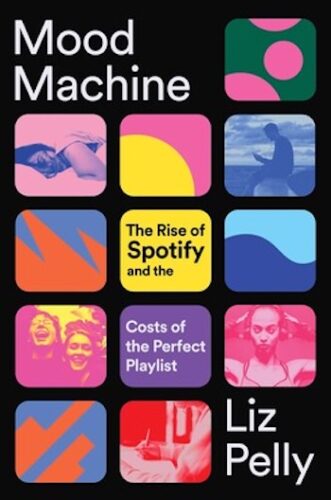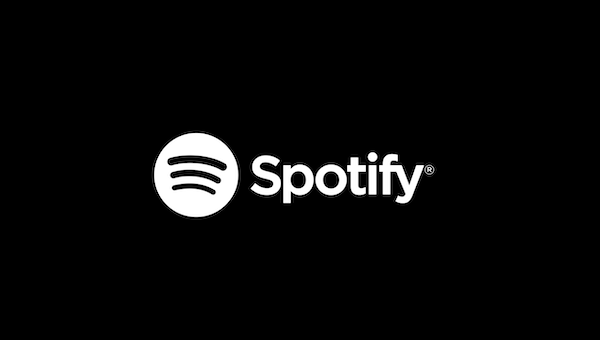Book Review: “Mood Machine” — In the Mood for Manipulation
By Steve Provizer
Some rugged individualists may want to break out of the corporate cycle of dependency. If they do, they might even come across music they love that they would never have dreamed existed in the Spotify universe.
 Mood Machine:The Rise of Spotify and the Costs of the Perfect Playlist by Liz Pelly. Atria/One Signal Publishers, 288 pages, $28.99
Mood Machine:The Rise of Spotify and the Costs of the Perfect Playlist by Liz Pelly. Atria/One Signal Publishers, 288 pages, $28.99
Author Liz Pelly lays out the sordid history of the streaming service Spotify in Mood Machine. It would be comforting to believe that the corporate actions described here represented a culmination of the depredations that technology wreaked on the arts. Unlikely. Not unless we (the body politic) thoroughly reevaluate our tolerance for surveillance and our laissez-faire attitude toward fairly paying musicians. And, oh yes, unless the capitalist system is dismantled.
Sweden was a hotbed of music piracy at the turn of this century; Spotify arose in that context. At first, founders Daniel Ek and Martin Lorentzon weren’t sure what they were going to sell on their platform. They settled on music mostly because they thought it would be cheap to acquire. And it was, given that the pair launched their corporation using music files they had downloaded from pirate sites. Adroitly, Ek and Lorentzon initially marketed their start-up as a way to counteract stealing, thus rejuvenating the moribund, archaic music industry. In fact, inspiring public pronouncements notwithstanding, the major decisions made by these would-be industry saviors were aimed from the get-to at maximizing profits. They ended up supercharging the old rapacious music industry model.
They enlisted Fred Davis, the son of music industry titan Clive Davis, to help Spotify negotiate with the major record labels. The labels wanted a percentage of each stream (not of any ads) and they got that. The majors agreed on free and paid tiers; the goal was to up-sell users. That said, most of the details in the agreement with the majors have been kept secret. Indies negotiated a second-rate deal. The royalty system is so labyrinthine that nobody really understands it.
Spotify was obsessed with fact-finding — every interaction with the company is recorded. Research revealed the psychological importance that music played as background sound rather than as primary experience. That led the company to champion what Pelly calls the “dynamics of passivity.” The increasing popularity of sleep playlists is an apt symptom of this approach of passive engagement with music. Playlists that supplied apt “music for every moment” became much sought after because they ensured a user’s perpetual engagement with Spotify playlists. The majors labels bought up playlist companies to ensure their product was well represented on these lineups. Wellness and self-improvement were used as key words to buttress the bona fides of these playlists.
Along the way “PFC” — perfect fit content — was concocted These are cheap tracks — generated by anonymous musicians — that Spotify put into playlists for listeners who, they said, wouldn’t know the difference. Twenty songwriters supplied 500 different noms de plumes and produced thousands of such tracks. They even invented bogus bios for these pseudonyms. How many of these tracks are actually generated by AI? No one can say.
In the same way that our friend the algorithm has been used to keep people on social media sites, it was mobilized to concoct “Algotorial” playlists that drew on the enormous amounts of data Spotify had collected on its users. The idea was that, by individualizing playlists, people would be discouraged from venturing outside of profitable parameters. The less users had to use their brains, the fewer buttons they had to press, the better. Mindless ease was key — “AI DJ” was invented for that purpose.
It should surprise no one that Spotify is interested in “neuro-marketing.” The company has acquired patents for sophisticated “emotion detection technology,” which utilizes brainwave monitors to analyze “Alexa-like” prompts. Seems like lie detector tests to me, which are inadmissible as evidence in court, but it works well enough for people who want to sell you stuff. “ID synching-data gatherers” bring the accumulated information together to shape a personalized picture of individual listeners. Users don’t know how many times — and to whom — their data is being sold. Pelly claims that some people’s data has been used to evaluate applications for loans. Other countries mandate transparency in this industry. Not here. Pelly says it’s possible in the US for listeners to request Spotify’s data, but she doesn’t say exactly how.
Spotify could have taken the route of the “long tail model” — the idea is that the service could fill many small musical niches rather than a few large ones. The sheer number of the former would make financial sense for the music biz and support many more musicians. The company opted to maintain the old corporate model.

Liz Pelly. Photo: NYU
Rather than serving the needs of most musicians, Spotify is about monetizing them by selling them ads and products that will boost their music by placing it advantageously on the service. “Discovery Mode” guarantees good placement in playlists — in exchange for reduced royalties. Pelly likens reduced royalty payments, as a swap for preferred placement in playlists, to radio payola — “pay to play.” I’m not sure it’s an exact parallel. Still, in any system that corrals players with lesser and greater resources into making binding agreements, the advantage will always go to the well-financed player.
Pelly rues the fact that solo acts have a financial leg up in the Spotify game. But that was always true: struggling musicians have always figured out that groups of players make less money than solo acts. (She also mentions that some indie labels claim that working the Spotify system to get better playlist placement has done their artists good.)
Spotify provides data that allows musicians to closely track their audience, and, of course, the musicians themselves are being tracked on the ways they use that tracking. Pelly is disheartened by the attention that musicians pay to this data, arguing that online communities are being driven by data and thus consciously contributing to the apotheosis of data as a sine qua non, elevating it above creativity.
And this idea brings me to a larger point about the general tone and approach of Mood Machine.
There’s a sensibility here that I sometimes find cloying. The fault does not always lie in The System. It’s also about us; about the user. Putting the blame for a failing or failed arrangement completely on economic (and tech) machinery cedes control to those at the top of that pyramid and doesn’t hold the vast bottom accountable.
Pelly wants to take us “back to the garden,” when musicians were treated justly, except I’m not sure there ever was a garden. The manipulation of playlists by Spotify is egregious. But there’s nothing new about this kind of chicanery. Mainstream radio was always heavily mediated by advertisers (and payola). She debunks the idea that playlists are useful as forms of therapy, but you can’t sell music as “wellness” and “self-improvement” to people who don’t buy into the concept.
Pelly comes from the indie music world — she managed a Brooklyn indie music venue. At that time there was an ecosystem of indie newspapers, and mp3 websites that died, and she romanticizes it. She roots for musicians, as she should. But I’m not sure she does them or her admirable agenda any good by fostering the flawed idea that small cozy scenes are enough — especially given that musicians grow older, which means taking on more financial responsibilities. The author’s charge that user-generated playlists commodified the mixtape is true, but the fact is that most people are interested in being paid for what they choose to spend their time doing. When Pelly downplays financial pressures, she sometimes seems to imply that a musician doesn’t — or shouldn’t — want more people to like their music. It’s my experience that musicians may have to adjust to reality — that they’re not going to grow a larger audience or get better gigs — but they won’t like it.

Hustling is the order of the day, and streaming can only take part of the blame for that. Surviving as a musician has never been easy. The notion that the internet is a platform that would contribute to the democratization of distribution has been, to say the least, overhyped. Except among the lucky few, for the last 25 or so years the musicians who had the best chance of prospering have had to publicize themselves and master the necessary technology to do so.
Legal action against Spotify by the Federal Trade Commission is going to be a predictable nonstarter but, in her conclusion, Pelly lets some rays of light into what has been a grim picture for musicians. There are encouraging examples of union activism and artist cooperatives finding ways to provide support and some income to musicians. The United Musicians and Allied Workers (UMAW and more jazz-affiliated Music Workers Alliance — MWA — managed to lobby effectively and have a bill created: The Living Wage for Musicians Act would ask for the establishment of an “Artist Compensation Royalty Fund” to be paid by users and digital streaming services.
Improving the lot of musicians and other artists will probably necessitate developing independent, collaborative projects that operate outside the corporate institutional structure. At one point, in the late ’90s, people became fed up with the corporatization of radio and developed an ecosystem of alternative radio — community and pirate broadcasting — that resulted in the licensing of Low Power FM (LPFM) stations by the FCC.
The same kind of resourceful energy will be needed to mobilize streaming alternatives. In fact, a number of public libraries have begun to stream music, with an emphasis on local musicians. I’m trying to get mine — The Gloucester Lyceum and Sawyer Free Library — to join the movement. Here’s more info on this effort.
It’s hard to imagine, but the next hot corporate platform will probably be even more Big Brother-like than Spotify. Many music consumers will be content to place themselves in the comforting hands of the algorithm. But some rugged individualists will want to break out of the corporate cycle of dependency, if only to protect their own privacy and to support musicians. Another payoff: they might even come across music they love that they would never have dreamed existed in the Spotify universe.
Steve Provizer writes on a range of subjects, most often jazz and the arts here.

Great exploration of the concepts. Thanks!